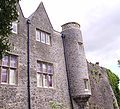St Fagans Castle
| St Fagans Castle | |
|---|---|
| Native name Welsh: Castell Sain Ffagan | |
 The approach to St Fagans Castle | |
| Location | St Fagans, Cardiff, Wales |
| Coordinates | 51°29′09″N 3°16′04″W / 51.4859°N 3.2677°WCoordinates: 51°29′09″N 3°16′04″W / 51.4859°N 3.2677°W |
| Built | c. 1580s |
| Architectural style(s) | Elizabethan |
Listed Building – Grade I | |
| Official name | St Fagans Castle |
| Designated | 10 June 1977 |
| Reference no. | 13888[1] |
St Fagans Castle (Welsh: Castell Sain Ffagan) is an Elizabethan mansion in St Fagans, Cardiff, Wales, dating from the late 16th century. The house and remaining medieval fortifications are Grade I listed. The grounds of St Fagans Castle now contain St Fagans National Museum of History.
History[]
A medieval castle dating from the 13th century previously existed on the site. By 1536 it lay in ruins. By 1563 the site had been sold to a Dr John Gibbon. A new house was built on the site either by Gibbon or by Nicholas Herbert, who bought the site from Gibbon in 1586.[2] Part of the D-shaped medieval boundary fortifications remain, forming a wall around the current house.[3]
Sir Edward Lewis of The Van, Caerphilly, bought the house in 1616 and the interior dates partly from then and partly from after 1850, when it began use as the preferred summer home of the senior branch of the Windsor-Clive family.[4] These were from 1905 elevated to the Earldom of Plymouth. Their (Lord Windsor) ownership arose in 1833, namely since its passing to Lady Harriet Clive, wife of the 13th Lord Windsor. She then had carried out decades of restorations.[5] The sequence of terraces in the gardens was created for the Windsor-Clives in 1865–6 and extended in the early 20th century.[4] The house became a convalescent hospital for soldiers during World War I, with the banqueting hall containing a ward of 40 beds.[6]
In 1947 the family gave the estate to the Amgueddfa Cymru - National Museum Wales.
Building alongside and grounds accommodate the former Welsh Folk Museum, St Fagans National Museum of History.[7]
The castle is statutorily recognised and protected in the highest category (Grade I) since 1977.[1] The lead water cistern in the courtyard is Grade II* listed,[8] Many garden structures have initial, mainstream Grade II status.[2]
Gallery[]

Courtyard and lead cistern

North facade and gardens

Western wall
Part of west wall and old fortifications

Stable block

Gardens and medieval ponds
References[]
- ^ a b "St Fagans Castle, St Fagans". British Listed Buildings. Retrieved 15 November 2013.
- ^ a b St Fagans Castle Archived 2013-10-23 at the Wayback Machine, Royal Commission on the Ancient and Historical Monuments of Wales. Retrieved 2013-09-12.
- ^ Browne, D. M.; Griffiths, Prof R. A. (2000), Glamorgan: Later Castles, Royal Commission on the Ancient and Historical Monuments of Wales, pp. 341–345, ISBN 1-871184-22-3
- ^ a b Newman, John (1995), Glamorgan, The Buildings of Wales, London: Penguin, pp. 561–2
- ^ "Death Of The Baroness Windsor". The Cardiff and Merthyr Guardian. 13 November 1869. p. 5 – via British Newspaper Archive.
- ^ "St Fagans 'hidden' gems give World War I insight", BBC News, 21 July 2013. Retrieved 2013-09-12.
- ^ Glamorgan: The Greater Houses, Royal Commission on the Ancient and Historical Monuments of Wales, 1981, p. 246, ISBN 0-11-700754-4
- ^ "Lead Cistern in the east forecourt of St Fagans Castle, St Fagans". British Listed Buildings. Retrieved 12 September 2013.
External links[]
![]() Media related to St Fagans Castle at Wikimedia Commons
Media related to St Fagans Castle at Wikimedia Commons
- St Fagans Castle and Gardens, St Fagans National Museum of History
- Castles in Cardiff
- Castle ruins in Wales
- Historic house museums in Wales
- Country houses in Wales
- Grade I listed buildings in Cardiff
- St Fagans National Museum of History
- St Fagans






